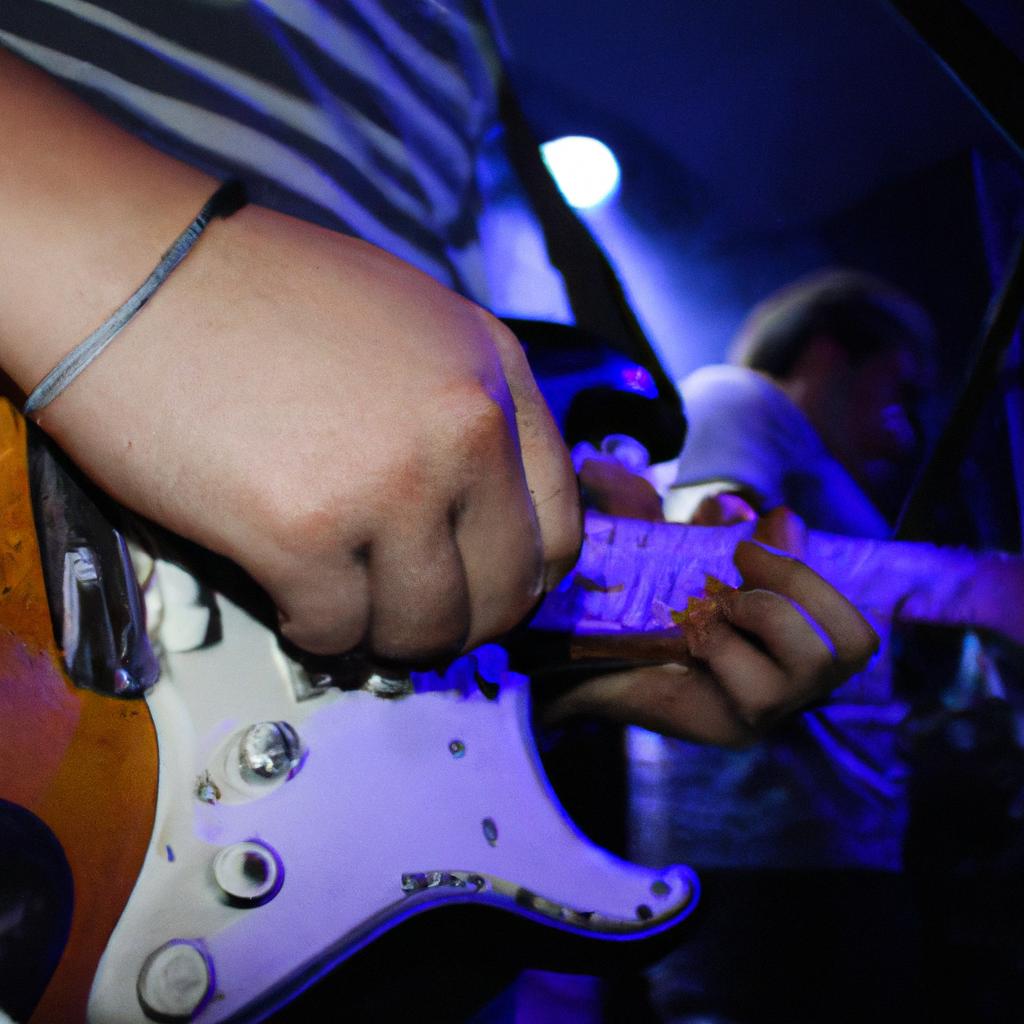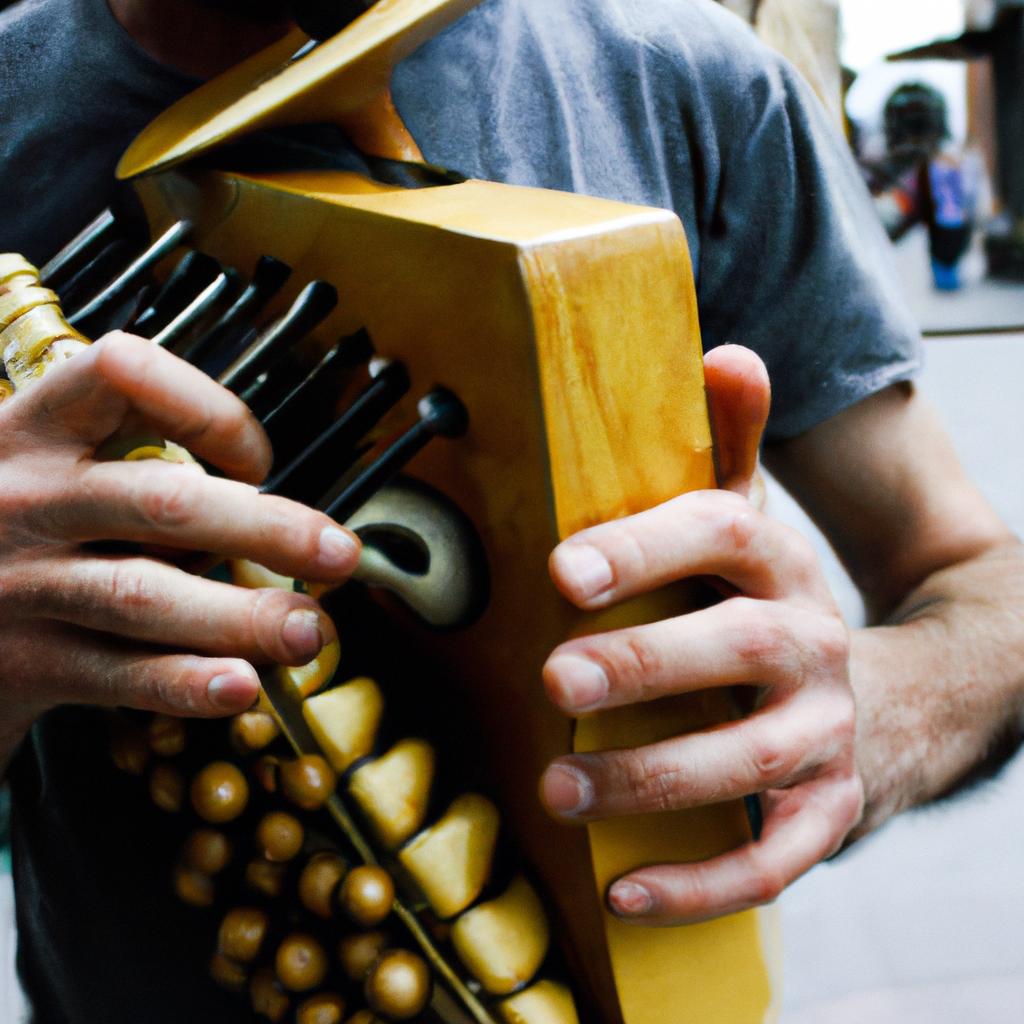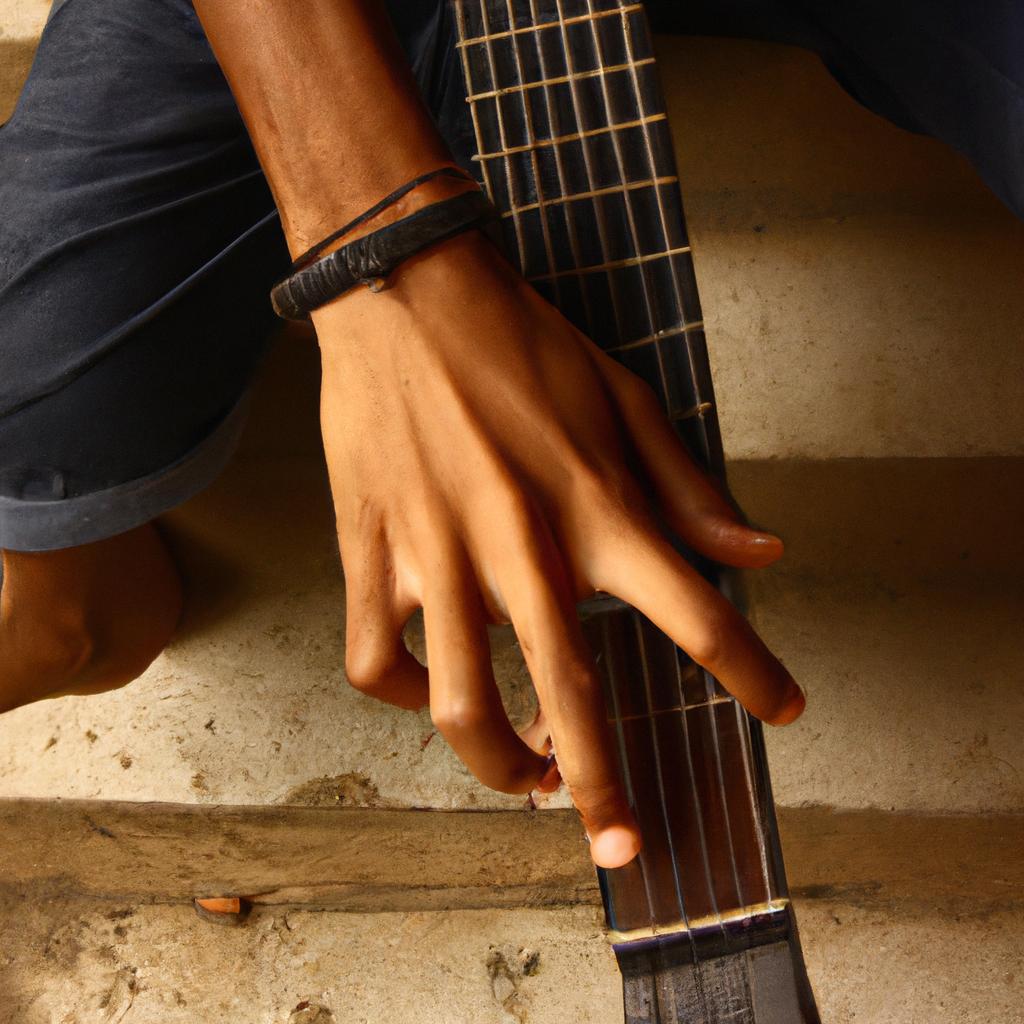Gothic rock, a subgenre of alternative rock originating in the late 1970s, has captivated audiences with its dark and brooding aesthetic. Defined by its haunting melodies, introspective lyrics, and atmospheric soundscapes, gothic rock offers a unique blend of melancholic beauty and macabre themes. This article examines the rise and evolution of gothic rock, shedding light on its emergence as a significant force within the broader realm of music.
To illustrate the enduring allure of gothic rock, let us consider the case study of The Sisters of Mercy. Formed in Leeds, England in 1980, this influential band quickly gained recognition for their distinct sound characterized by Andrew Eldritch’s deep baritone vocals set against an atmospheric backdrop of swirling guitars and pulsating rhythms. Their debut album “First and Last and Always” (1985) became an iconic landmark in gothic rock, showcasing their ability to seamlessly fuse elements from post-punk and psychedelic rock into a cohesive sonic tapestry that captured listeners’ imaginations.
Throughout this article, we will explore how gothic rock emerged as a genre deeply rooted in introspection and self-reflection. We will examine the influences that shaped its development and discuss key artists who contributed to the genre’s evolution. From the early pioneers like Bauhaus and Siouxsie and the Banshees to later bands such as The Cure and Fields of the Nephilim, we will delve into their unique contributions to gothic rock’s sonic palette.
Additionally, we will analyze the thematic elements that define gothic rock, including topics like death, despair, romanticism, and existential introspection. We’ll explore how these themes are often expressed through poetic lyrics, haunting melodies, and atmospheric production techniques. Furthermore, we’ll examine how gothic rock has been influenced by literature, art, and film – drawing inspiration from Gothic novels like Mary Shelley’s “Frankenstein” or Edgar Allan Poe’s works.
Furthermore, this article aims to shed light on the enduring influence of gothic rock beyond its initial heyday in the 1980s. We will discuss how contemporary artists continue to explore and reinterpret the genre today, infusing it with new elements while staying true to its core aesthetic. From bands like She Past Away and Drab Majesty to newer acts such as Ritual Howls and Molchat Doma; we will showcase how gothic rock remains a vital force within alternative music scenes worldwide.
In conclusion, this article serves as an exploration of gothic rock’s rise and evolution as a genre that captivates audiences with its dark allure. By examining key artists, thematic elements, and its ongoing influence in contemporary music, we aim to provide a comprehensive understanding of what makes gothic rock such a compelling subgenre within alternative music.
History of Gothic Rock
History of Gothic Rock
Gothic rock, often referred to as the darkwave in gothic music, emerged in the late 1970s and early 1980s as a subgenre of post-punk. It is characterized by its melancholic soundscapes and introspective lyrics, drawing inspiration from gothic literature, horror films, and the macabre. One notable example that exemplifies this genre is the band Bauhaus, whose iconic song “Bela Lugosi’s Dead” became an anthem for the goth movement.
The roots of gothic rock can be traced back to bands such as Joy Division and Siouxsie and the Banshees. These artists incorporated elements of punk rock with their own unique style, creating a gloomy atmosphere through haunting melodies and atmospheric instrumentation. As gothic rock gained popularity, it diversified into various subgenres like ethereal wave, deathrock, and coldwave.
To better understand the emotional impact of gothic rock on listeners, let us explore some characteristics commonly associated with the genre:
- Introspection: Gothic rock delves deep into personal emotions and themes like love, loss, isolation, and despair.
- Dark imagery: Lyrics often draw inspiration from gothic literature and incorporate poetic metaphors to create vivid visuals.
- Melancholy: The music evokes feelings of sadness or nostalgia through its minor chord progressions and brooding melodies.
- Ambiance: Atmospheric effects such as reverb-drenched guitars or eerie synthesizers are frequently used to enhance the mood.
Furthermore, we can examine how these characteristics manifest in one particular aspect of gothic rock: fashion. The table below illustrates common clothing choices associated with this enigmatic subculture:
| Clothing Item | Description | Emotional Response |
|---|---|---|
| Victorian Lace | Delicate lace patterns evoke a sense of elegance and mystery, reminiscent of a bygone era. | Intrigue |
| Leather Jacket | A symbol of rebellion and individualism, the leather jacket adds an edgy element to outfits. | Defiance |
| Fishnet Stockings | Often worn with skirts or shorts, fishnet stockings exude sensuality while maintaining an edge. | Seduction |
| Combat Boots | Sturdy and practical, combat boots are associated with resilience and strength. | Empowerment |
As we delve further into the influences on gothic rock in the subsequent section, it becomes evident that this subgenre is not simply defined by its musical elements but also encompasses a broader aesthetic and cultural sphere.
Moving forward, our exploration will focus on how external factors such as literature, film, art, and societal contexts shape the evolution of gothic rock. By examining these diverse influences, we can gain deeper insight into the multifaceted nature of this distinctive genre.
Influences on Gothic Rock
Section: Influences on Gothic Rock
The development of gothic rock was significantly influenced by various factors and musical genres. One instance that exemplifies the impact of these influences is the emergence of The Sisters of Mercy, a renowned gothic rock band formed in the early 1980s. Their music seamlessly blended elements from post-punk, new wave, and psychedelic rock, creating a distinct sound that would serve as a blueprint for future gothic bands.
Understanding the diverse range of influences can shed light on the evolution and unique characteristics of gothic rock. Here are some key aspects:
-
Post-Punk: Post-punk laid the foundation for gothic rock with its dark and introspective themes. Bands like Joy Division and Bauhaus infused their music with gloomy atmospheres, poetic lyrics, and brooding vocals – elements that would become synonymous with gothic rock.
-
New Wave: The advent of new wave introduced electronic sounds into alternative music scenes. Gothic rock artists incorporated synthesizers and drum machines to create haunting melodies and atmospheric textures, adding an ethereal quality to their compositions.
-
Psychedelic Rock: Drawing inspiration from psychedelic pioneers such as Pink Floyd and The Doors, gothic rock adopted hallucinatory guitar effects and experimental song structures. These elements contributed to the genre’s otherworldly ambiance.
-
Literature & Visual Arts: Gothic literature played a significant role in shaping the lyrical content of gothic rock songs. Themes revolving around darkness, romance, existentialism, death, and supernatural phenomena were often explored through poetic narratives reminiscent of writers like Edgar Allan Poe or Mary Shelley. Additionally, visual arts inspired album covers featured eerie imagery evoking a sense of mystery and allure.
To further illustrate these influences visually:
| Aspects | Description | Emotional Response |
|---|---|---|
| Dark Atmosphere | Emphasizes melancholy undertones | Intrigue |
| Poetic Lyrics | Explores profound emotions and existential themes | Reflection |
| Ethereal Melodies | Creates a dreamlike ambiance | Enchantment |
| Eerie Imagery | Evokes mystery and allure | Fascination |
In summary, gothic rock emerged as a result of various influences from post-punk, new wave, psychedelic rock, literature, and visual arts. These elements converged to create a distinct sound characterized by dark atmospheres, poetic lyrics, ethereal melodies, and eerie imagery. The next section will delve into the specific characteristics that define gothic rock as a genre.
Transitioning seamlessly into the subsequent section about “Characteristics of Gothic Rock,” we can explore how these influences translate into defining features within the genre.
Characteristics of Gothic Rock
Gothic Rock: The Darkwave in Gothic Music
Influences on Gothic Rock
As we delve into the rich tapestry of gothic rock, it is important to explore the diverse range of influences that have shaped this unique genre. One notable example can be found in the case of Siouxsie and the Banshees. Formed in 1976, this British band drew inspiration from various sources such as post-punk, glam rock, and even horror films. Their distinct sound fused together elements of atmospheric guitar riffs, haunting vocals, and introspective lyrics.
To gain a deeper understanding of the factors that have contributed to gothic rock’s evolution over time, let us examine some key influences:
- Post-Punk Movement: Emerging in the late 1970s and early 1980s, post-punk laid the groundwork for gothic rock by challenging traditional punk norms while embracing a darker aesthetic. Bands like Joy Division and Bauhaus paved the way with their brooding atmospheres and introspective themes.
- Literary References: Drawing inspiration from classic literature has been a recurring motif within gothic rock. Artists often incorporate themes from authors such as Edgar Allan Poe or Mary Shelley into their lyrics, adding an air of mystery and macabre beauty to their music.
- Visual Aesthetics: Visual aesthetics play a crucial role in shaping gothic rock’s identity. From elaborate stage costumes to dark makeup styles, bands like Sisters of Mercy embraced an image steeped in romanticism and melancholy.
- Electronic Innovations: With advancements in technology during the 1980s and beyond, electronic instruments began to influence gothic rock significantly. This integration allowed for experimentation with synthesizers and drum machines, creating new sounds that further expanded upon the genre’s sonic landscape.
Examining these influences reveals how gothic rock became more than just a musical style; it evolved into a subculture that encompassed fashion, literature, and visual art. In the subsequent section on “Characteristics of Gothic Rock,” we will explore the defining elements that make this genre truly distinct.
Gothic Rock Subgenres
Continuing our exploration of gothic rock, let us now turn our attention to its various subgenres. By examining these offshoots of the main genre, we can gain further insight into how gothic rock has continued to evolve and diversify over time.
Gothic Rock Subgenres
Transitioning from the previous section on the characteristics of Gothic Rock, we now delve into the various subgenres that have emerged within this dark and evocative genre. Understanding these subgenres provides a deeper appreciation for how Gothic Rock has evolved over time and showcases its versatility in capturing different facets of melancholy and introspection.
One notable example of a Gothic Rock subgenre is Darkwave. Originating in the late 1970s and early 1980s, Darkwave combines elements of synth-pop with eerie atmospheres and introspective lyrics. Often characterized by ethereal vocals, haunting melodies, and electronic instrumentation, Darkwave creates an otherworldly ambiance that transports listeners to realms of darkness and mystery.
To further explore the world of Gothic Rock subgenres, let us consider some common themes found across them:
- Introspection: Many Gothic Rock subgenres encourage self-reflection and deep contemplation through their lyrical content.
- Melancholy: A prevailing sense of sadness and longing permeates much of Gothic music, providing solace for those who resonate with such emotions.
- Occultism: Some subgenres incorporate esoteric themes like witchcraft, mysticism, or supernatural entities as symbols to convey profound meaning.
- Romanticism: Love and desire often take on a darker tone in Gothic Rock music, exploring unconventional aspects of relationships beyond societal norms.
To illustrate these themes more vividly, here is an emotive bullet point list depicting the essence of Gothic Rock:
- The haunting allure of minor chord progressions
- Ethereal voices echoing through dimly lit corridors
- Lyrics that evoke long-lost memories and hidden desires
- Melodies floating between despair and hope
Furthermore, a table showcasing three prominent Gothic Rock subgenres can help shed light on their unique qualities:
| Subgenre | Description | Notable Bands |
|---|---|---|
| Darkwave | Combines synth-pop with eerie atmospheres and introspective lyrics | Clan of Xymox, The Frozen Autumn |
| Ethereal Wave | Features ethereal vocals and atmospheric soundscapes | Dead Can Dance, Cocteau Twins |
| Post-Punk | Incorporates elements of punk rock while exploring darker themes | Siouxsie and the Banshees, Joy Division |
As we can see from this exploration of Gothic Rock subgenres, each one offers a unique perspective on darkness, melancholy, and introspection. From Darkwave’s electronic-infused ethereality to Ethereal Wave’s haunting vocals and atmospheric soundscapes, these subgenres provide a rich tapestry for fans to immerse themselves in.
Transitioning into the next section on “Famous Gothic Rock Bands,” we dive deeper into the notable artists who have shaped the genre through their contributions and influence.
Famous Gothic Rock Bands
As we delve deeper into the world of Gothic rock, it is essential to explore its various subgenres that have emerged over time. These subgenres exhibit distinct characteristics and musical elements, offering a diverse range of sounds within the broader spectrum of Gothic music. To illustrate this point further, let us consider one particular subgenre: Post-Punk.
Post-Punk can be seen as a precursor to Gothic rock, emerging in the late 1970s and early 1980s. The genre combines punk’s raw energy with introspective lyrics and atmospheric instrumentation. Bands like Joy Division and Siouxsie and the Banshees are often cited as prime examples of Post-Punk bands that laid the foundation for subsequent Gothic rock movements.
To better understand the vast landscape of Gothic rock subgenres, here are some notable categories worth exploring:
- Darkwave: This subgenre emphasizes synthesizers and electronic soundscapes while maintaining a melancholic atmosphere. Artists such as Clan of Xymox and Project Pitchfork exemplify this style.
- Ethereal Wave: Known for its ethereal vocals, dreamlike melodies, and poetic lyrics, Ethereal wave creates an otherworldly ambiance reminiscent of gothic literature. Dead Can Dance is considered one of the pioneers in this subgenre.
- Deathrock: Influenced by horror movies and punk aesthetics, deathrock features aggressive guitar riffs coupled with macabre lyrical themes. Christian Death is often regarded as one of the founders of this captivating subgenre.
- Coldwave: Originating in France during the late 1970s, coldwave incorporates minimalist synth-driven compositions infused with dark undertones. Bands like Trisomie 21 embody this unique fusion between post-punk and new wave elements.
| Subgenre | Characteristics | Notable Artists |
|---|---|---|
| Darkwave | Emphasizes synthesizers and electronic soundscapes | Clan of Xymox |
| Maintains a melancholic atmosphere | Project Pitchfork | |
| Ethereal Wave | Features ethereal vocals and dreamlike melodies | Dead Can Dance |
| Evokes an otherworldly ambiance | ||
| Deathrock | Combines horror movie influences with punk aesthetics | Christian Death |
| Incorporates aggressive guitar riffs and macabre themes | ||
| Coldwave | Minimalist synth-driven compositions | Trisomie 21 |
| Infused with dark undertones |
Understanding the various subgenres within Gothic rock allows for a more nuanced appreciation of this captivating genre. By exploring these different styles, listeners can discover new sounds that resonate deeply with their emotions, whether it be the haunting atmospheres of Darkwave or the raw intensity found in Deathrock. Now, let us move forward to examine some famous Gothic rock bands and their contributions to the genre.
Impact of Gothic Rock
Famous Gothic Rock Bands have had a significant impact on the development and popularity of the genre. Their unique sound, dark aesthetic, and introspective lyrics have captivated audiences around the world. As we delve deeper into the realm of Gothic rock, it becomes evident that its influence extends far beyond just music.
One notable example is The Cure, an English band formed in 1976. With their melancholic melodies and Robert Smith’s distinctive vocals, they became pioneers of gothic rock. Their album “Disintegration” (1989) remains one of the most influential releases in the genre, showcasing their ability to create atmospheric and emotionally charged music.
The impact of Gothic rock can be seen not only through its musical contributions but also by examining its cultural significance. Here are some key aspects that highlight this influence:
-
Fashion: Gothic rock has inspired a distinct fashion style characterized by black clothing, lace, leather, and extravagant accessories such as chokers or corsets. This subculture embraces a darker aesthetic that reflects the emotional depth found within gothic music.
-
Artistic Expression: Many artists have been influenced by gothic themes in their work. Paintings, illustrations, and photography often incorporate elements of darkness and mystery present in gothic culture. These visual representations provide further avenues for self-expression within the community.
-
Literature: Gothic literature has long served as a source of inspiration for both musicians and fans alike. Works like Mary Shelley’s “Frankenstein” or Bram Stoker’s “Dracula” embody the same sense of darkness and introspection found within gothic rock songs. This shared fascination with macabre narratives creates a connection between various forms of artistic expression.
-
Community Bonding: The gothic subculture fosters a strong sense of community among its members. Events such as concerts or festivals become gathering points where individuals who share similar interests can connect with each other. These spaces provide a sense of belonging and camaraderie, allowing fans to express themselves freely.
By exploring the impact of Gothic rock beyond its musical realm, we can appreciate its profound influence on various aspects of culture. From fashion to literature and art, this genre has left an indelible mark that continues to resonate with individuals seeking solace in darkness. The next section will delve into the broader societal implications brought about by the rise of gothic rock music.




